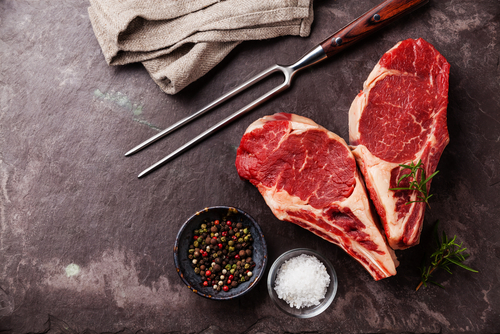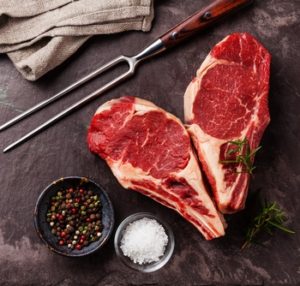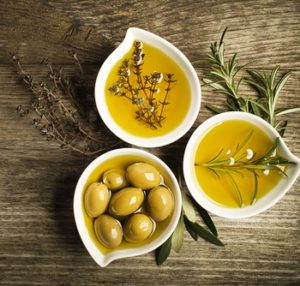Top 9 Healthiest Foods to Eat to Lose Weight and Feel Great

Thanks to modern medicine, people’s life expectancy has never been higher.
But one negative aspect of modernization and technology is the increased availability of highly processed junk food.
Junk food is often high in calories and full of unhealthy ingredients that are associated with an increased risk of chronic disease. Good examples are added sugar and trans fats.
Even if you banish the unhealthy modern foods from your diet, you can still eat an endless variety of healthy and delicious foods.
This article was originally posted on https://www.healthline.com/nutrition/top-9-healthiest-foods-to-eat
-
Meat
This includes beef, pork, lamb, chicken and various other animals.
 Humans are omnivores and have been eating both plants and meat for hundreds of thousands (if not millions) of years.
Humans are omnivores and have been eating both plants and meat for hundreds of thousands (if not millions) of years.
The problem is that today’s meat isn’t like it used to be. It’s often harvested from animals that ate grains and were pumped full of hormones and antibiotics to make them grow faster (1).
Before the industrial revolution, meat came from animals that were allowed to roam and graze on various plants, and they were not injected with growth promoters. This is what meat is supposed to be like.
For example, the natural diet of cows consists of grass, not grains. Beef from grass-fed cows has a much better nutrient profile. It contains (2, 3, 4):
- More omega-3 and less omega-6.
- Much more conjugated linoleic acid(CLA), which can lower body fat and increase lean mass.
- More vitamin A, vitamin E and the cellular antioxidant glutathione.
Simply put, it’s a great idea to consume fresh meat from healthy, naturally raised animals.
Conversely, you should limit your intake of processed meat, which has been linked to various health problems.
Summary: Eat fresh meat from animals that were raised and fed in a natural way. It’s healthier and more nutritious.
-
Fish
Popular types of fish include salmon, trout, haddock, cod, sardines and many others.
In nutrition, people tend to disagree a lot. However, one the few things that everyone seems to agree upon is that fish is good for you.
Fish is rich in high-quality proteins, various essential nutrients and omega-3 fatty acids, which promote heart and brain health.
Omega-3 fatty acids appear to be especially important for mental health and the prevention of heart disease (5).
They are also very beneficial for depression, which means that eating fish 1–2 times per week may make you feel better every single day (6).
However, because of ocean pollution, some large and older fish may contain high levels of contaminants, such as mercury.
But in general, the health benefits of fish far outweigh any potential risks (7).
Summary: Fish is very healthy and eating it is associated with a much lower risk of depression, other mental disorders and several chronic diseases.
-
Eggs
Eggs are among the healthiest foods on the planet, and the yolk is by far the most nutritious part.
Just imagine, the nutrients contained in one egg are enough to grow an entire baby chicken.
Despite what some health experts have claimed for the past few decades, eating eggs does not give you heart attacks.
Eating eggs changes your LDL cholesterol from small, dense (bad) to large (good), all while increasing your “good” HDL cholesterol (8).
It also provides the unique antioxidants lutein and zeaxanthin, both of which are very important for eye health (9).
Eggs are high on the satiety index, which means they help you feel full and may promote lower calorie intake (10).
A study in 30 overweight and obese women revealed that a breakfast of eggs caused them to eat fewer calories for up to 36 hours, compared to a bagel breakfast (11).
Just keep in mind that the way you cook eggs may affect their overall benefits. Poaching and boiling are probably the healthiest cooking methods.
Summary: Eggs are highly nutritious and so filling that they make you eat fewer overall calories. They’re among the healthiest foods on the planet.
-
Vegetables
 Vegetables include spinach, broccoli, cauliflower, carrots and many others.
Vegetables include spinach, broccoli, cauliflower, carrots and many others.
They are rich in fiber, antioxidants and nutrients that are important for your body.
In observational studies, eating vegetables is associated with a lower risk of cancer, diabetes and heart disease (12, 13, 14, 15).
It’s recommended to eat vegetables every day. They are healthy, filling, low in calories and a good way to add variety to your diet.
Summary: Vegetables are high in fiber, antioxidants and nutrients but very low in calories. Eat a variety of vegetables every day.
-
Fruit
Like vegetables, fruits and berries are associated with various health benefits and a reduced risk of chronic disease.
They’re high in fiber, antioxidants and vitamin C, have a low energy density and are almost impossible to overeat.
Although fruits and berries are among the healthiest foods you can find, you need to moderate your intake if you are on a low-carb diet. They are still pretty high in carbs.
However, some fruits contain fewer carbs than others.
Summary: Fruits are among the healthiest whole foods. They are also tasty, increase dietary variety and don’t require preparation.
-
Nuts and Seeds
Common nuts and seeds include almonds, walnuts, hazelnuts, macadamia nuts, sunflower seeds, pumpkin seeds and many others.
Nuts and seeds contain a lot of essential nutrients and are particularly high in vitamin E and magnesium.
Despite a high energy density and fat content, eating nuts is associated with improved insulin sensitivity, lower body weight and improved health (16, 17, 18).
However, nuts are high in calories and can hinder weight loss for some people. Therefore, eat nuts in moderation if you find yourself constantly snacking on them.
Summary: Nuts and seeds are nutritious, healthy and generally associated with improved health. Eat them, but not too much.
-
Tubers
Root vegetables like potatoes and sweet potatoes are healthy, nutritious and very filling.
Many populations around the world have relied on tubers as a dietary staple and remained in excellent health (19).
However, they are still very high in carbs, mainly starch, and prevent the metabolic adaptation required to reap the full benefits of low-carb diets.
Starchy tubers like potatoes contain a healthy type of fiber known as resistant starch.
Cooking potatoes and allowing them to cool overnight is an excellent way to increase their resistant starch content.
Summary: Tubers and root vegetables are good examples of healthy, high-carb foods that provide a variety of beneficial nutrients.
-
Fats and Oils
 Supplement your diet with some healthy fats and oils, such as olive oil and fish oil.
Supplement your diet with some healthy fats and oils, such as olive oil and fish oil.
Fish oil supplements are among the best sources of omega-3s and vitamin D. If you don’t like the taste, you can buy them in capsule form.
For high-heat cooking, it’s best to choose saturated fats like coconut oil and butter. Their lack of double bonds makes them more resistant to high heat (20).
Olive oil is also an excellent cooking oil, while extra virgin olive oil is great as a salad dressing. Both have been linked to a reduced risk of chronic disease (21, 22).
Summary: Supplement your diet with some healthy saturated and monounsaturated fats. If appropriate, take some fish liver oil each day.
-
High-Fat Dairy
High-fat dairy products include cheese, cream, butter and full-fat yogurt.
High-fat dairy products are rich in saturated fats, calcium and other nutrients.
Dairy products made from the milk of grass-fed cows is rich in vitamin K2, which is important for bone and cardiovascular health (23, 24).
In one large review, the consumption of high-fat dairy was associated with a lower risk of weight gain over time (25).
Observational studies from Holland and Australia revealed that those who ate the most high-fat dairy had a much lower risk of cardiovascular disease and death, compared to those who ate the least (26, 27).
Of course, these observational studies don’t prove that high-fat dairy caused the improvement, and not all studies agree on this.
However, it definitely suggests that high-fat dairy products aren’t the villain they’ve been made out to be.
